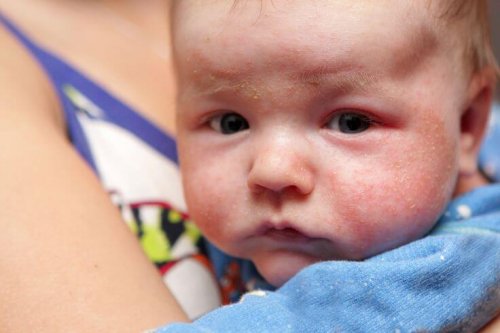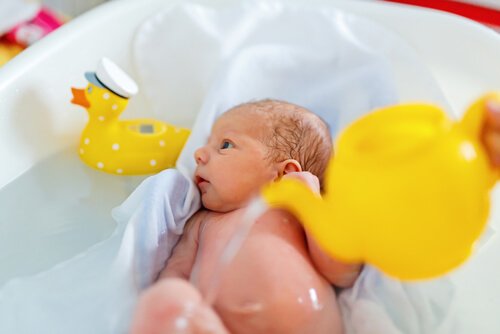What Causes Flaky Skin on Newborns?

A newborn’s skin is extremely fragile and will continue to change in appearance during the first weeks of life. This may include a small amount of flaking that shouldn’t alarm parents. It’s normal. But if you’re wondering what causes that flaky skin on newborns, keep reading.
Certainly, the appearance of flakes or scales on a newborn’s skin can occur on any part of the body. However, it especially occurs on the hands, soles of the feet and ankles. It happens because babies lose the outer layer of their skin in the first two or three weeks after birth.
Also, the amount of flakes on the skin may vary. This often depends on whether a premature delivery occurred. In other cases, the flakes may appear as a result of conditions that require treatment.
However, a certain degree of dryness after birth is completely normal and usually goes away on its own. In general, this doesn’t require any special care on your part.
Causes of flaky skin on newborns
If your baby’s skin seems very dry or begins to peel in the weeks after birth, knowing what causes this may relieve your worries. Causes may include:
1. Ichthyosis
First, a genetic condition called ichthyosis can cause peeling and dryness. This skin condition also causes scaling, itching and skin detachment.
Your pediatrician can diagnose your baby with this condition according to your family’s medical history and after performing a physical examination. During this exam, the doctor may also take a blood or skin sample.
No cure for ichthyosis exists, but regularly applying creams will relieve dryness and improve the condition of your baby’s skin.
2. Eczema
In some cases, peeling and dry skin are caused by a skin condition called eczema or atopic dermatitis. Eczema can cause dry, red and itchy patches on the baby’s skin.

This condition doesn’t usually appear immediately in the post-natal period, but it may develop later in childhood. Its exact cause remains unknown, but researchers believe several factors can trigger an outbreak, including exposure to irritants such as shampoos and detergents.
Tips for reducing flaky skin on newborns
If your little one seems uncomfortable with all their peeling skin, the most important thing is to relieve their discomfort. In addition to this care, the love and special attention of the mother and father will help the most.
Here are some tips that will allow you to reduce flaky skin on newborns:
1. Warm water baths
Hot water dries the skin of people of any age, including newborns. If your little one has flaky skin, don’t use hot water.
Warm water baths are ideal for a newborn’s sensitive skin. Always follow the special recommendations for newborn hygiene.
“The amount of flakes on the skin can vary. This often depends on whether the delivery was premature, on time or delayed.”
2. Use baby shampoo
To help treat and prevent flaking skin, only bathe your newborn with a shampoo specially formulated for babies. The soap you use on your own skin is likely too rough for the delicate skin of a baby.
3. Use a humidifier
Using a humidifier at home can make a difference in treating your baby’s skin. Humidifiers add moisture to the air, which helps treat and prevent flaky skin.
It’s extremely simple to do: place the humidifier in the room where the baby spends the most time. Let it run for a few hours any time the air feels a little dry.
4. Limit bath time
Baths can have an adverse effect on your baby’s skin. Prolonged periods in bath water can wash out the natural oils in their skin and leave your baby more susceptible to flaking. Therefore, reduce bath time and you should quickly see a difference in your baby’s skin.

5. Hydrate your baby often
Maintaining constant water levels in the body is absolutely necessary. Strictly follow the established routine for breastfeeding or formula feeding, and avoid omissions. Feeding and hydration help put moisture back into the skin.
Finally, remember that the appearance of flaky skin on a newborn is normal. Don’t worry too much about it. In any case, with this list of possible causes and the advice presented here, you’ll know why it’s happening and how to remedy it.
All cited sources were thoroughly reviewed by our team to ensure their quality, reliability, currency, and validity. The bibliography of this article was considered reliable and of academic or scientific accuracy.
- Guimaraes Proenca, N. (1990). Psoriase na crianca. Anais Brasileiros de Dermatología.
- Ribes C, Moraga L. Recién nacido: lesiones cutáneas benignas transitorias.
- Verbov J. Common skin conditions in the newborn. Semin Neonatol 2000; 5: 303-10.
This text is provided for informational purposes only and does not replace consultation with a professional. If in doubt, consult your specialist.








